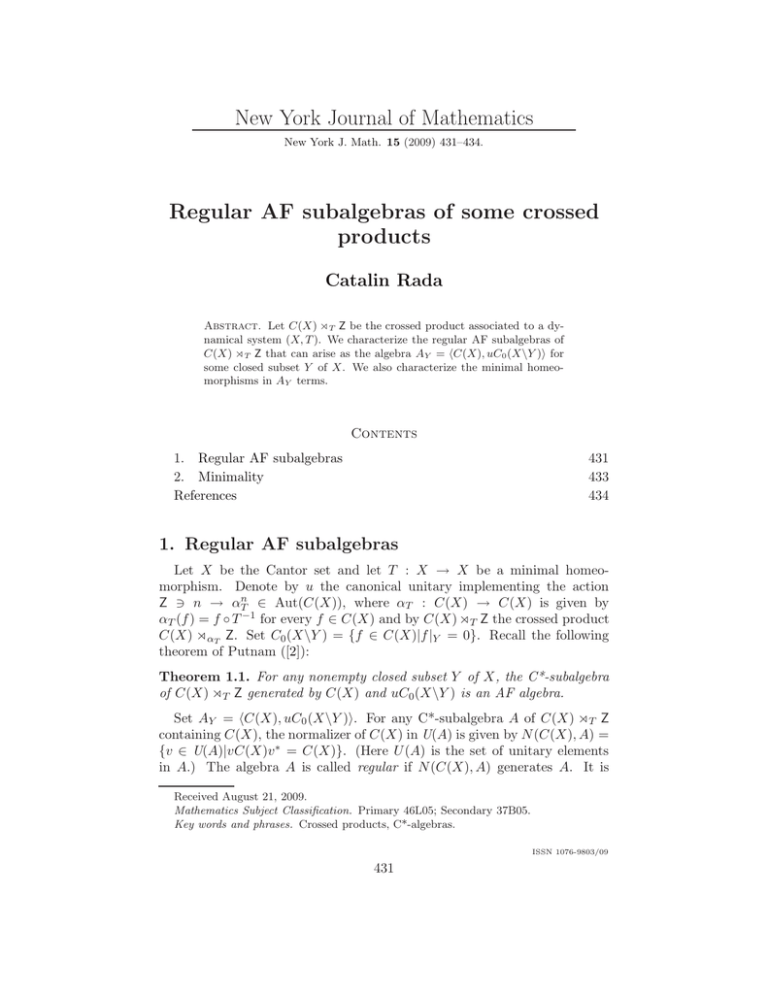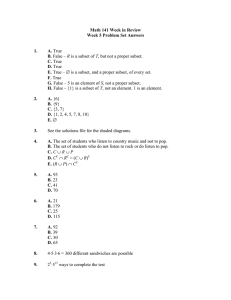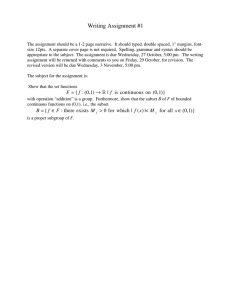New York Journal of Mathematics Regular AF subalgebras of some crossed products
advertisement

New York Journal of Mathematics
New York J. Math. 15 (2009) 431–434.
Regular AF subalgebras of some crossed
products
Catalin Rada
Abstract. Let C(X) T Z be the crossed product associated to a dynamical system (X, T ). We characterize the regular AF subalgebras of
C(X) T Z that can arise as the algebra AY = C(X), uC0 (X\Y ) for
some closed subset Y of X. We also characterize the minimal homeomorphisms in AY terms.
Contents
1. Regular AF subalgebras
2. Minimality
References
431
433
434
1. Regular AF subalgebras
Let X be the Cantor set and let T : X → X be a minimal homeomorphism. Denote by u the canonical unitary implementing the action
Z n → αnT ∈ Aut(C(X)), where αT : C(X) → C(X) is given by
αT (f ) = f ◦ T −1 for every f ∈ C(X) and by C(X) T Z the crossed product
C(X) αT Z. Set C0 (X\Y ) = {f ∈ C(X)|f |Y = 0}. Recall the following
theorem of Putnam ([2]):
Theorem 1.1. For any nonempty closed subset Y of X, the C*-subalgebra
of C(X) T Z generated by C(X) and uC0 (X\Y ) is an AF algebra.
Set AY = C(X), uC0 (X\Y ). For any C*-subalgebra A of C(X) T Z
containing C(X), the normalizer of C(X) in U(A) is given by N (C(X), A) =
{v ∈ U(A)|vC(X)v ∗ = C(X)}. (Here U (A) is the set of unitary elements
in A.) The algebra A is called regular if N (C(X), A) generates A. It is
Received August 21, 2009.
Mathematics Subject Classification. Primary 46L05; Secondary 37B05.
Key words and phrases. Crossed products, C*-algebras.
ISSN 1076-9803/09
431
432
Catalin Rada
well-known that AY is regular. Another property of AY is contained in the
following result of Poon (see [1]):
Theorem 1.2. Let Y be a nonempty subset of X. For every n 1 and any
clopen subset W of X one has that un χW (= uχT n−1 (W ) uχT n−2 (W ) . . . uχW ) ∈
AY if and only if uχT n−1 (W ) , uχT n−2 (W ) , . . . , uχW ∈ AY . (Here χW denotes
the characteristic function of W .)
We say that a C*-subalgebra A of the crossed product C(X) T Z has
property if for any n 1 and any clopen subset W of X,
uχT n−1 (W ) , uχT n−2 (W ) , . . . , uχW ∈ A
whenever un χW ∈ A.
Theorem 1.3. For any regular AF subalgebra A of C(X)T Z that contains
C(X) and has property , there is a closed nonempty set Y of X such that
AY = A.
Let us find the natural candidate for Y . Consider the set
I = {f ∈ C(X) | uf ∈ A} ⊆ C(X).
Lemma 1.4. The subset I is a closed ideal of C(X).
Proof. If f, g ∈ I then uf, ug ∈ A, and since A is an algebra u(f + g) =
uf + ug ∈ A, so f + g ∈ I. If f ∈ I and g ∈ C(X) then uf ∈ A and
since g ∈ C(X) ⊆ A we get uf g ∈ A, hence f g ∈ I. Remark that since
g ◦ T −1 ∈ C(X) ⊆ A and uf ∈ A we get that ugf = (g ◦ T −1 )uf ∈ A,
hence gf ∈ I. Suppose that fn → f and fn ∈ I. Then ufn → uf , and since
ufn ∈ A it follows that uf ∈ A, hence f ∈ I.
Since I is an ideal in C(X) we know that I = C0 (X\Y ) for some closed
subset Y of X. Since A is AF we see that u is not in A, so Y is not empty.
Lemma 1.5. The inclusion AY ⊆ A is always valid.
Proof. It is sufficient to show that the generators of AY are in A. By the
definition of A we know that C(X) ⊆ A. If f ∈ C0 (X\Y ) = I then uf ∈ A,
hence uC0 (X\Y ) ⊆ A. Therefore AY ⊆ A.
Lemma 1.6. The inclusion A ⊆ AY holds.
Proof. Since A is a regular algebra it is enough to show that each unitary
in N (C(X), A), it is
in N (C(X), A) is also in AY . Letting v be
a unitary
pn un , where f is a unitary in
known from Lemma 5.1 of [2] that v = f
n∈Z
only finitely many pn are different
C(X), every pn is a projection in C(X),
pn = 1. Since the projections pn are
than 0, pn pk = 0 for n = k and
n∈Z
orthogonal, we obtain that pn un ∈ A for every n ∈ Z.
Regular AF subalgebras of some crossed products
433
We show that pn un ∈ AY . Suppose that n 1. If pn = χW for a
clopen subset W of X, from the chain of equalities pn un = un (pn ◦ T n ) =
un χT −n (W ) = uχT −1 (W ) uχT −2 (W ) . . . uχT −n (W ) and the condition,
uχT −1 (W ) , uχT −2 (W ) , . . . , uχT −n (W ) ∈ A.
Hence we see that χT −1 (W ) , χT −2 (W ) , . . . , χT −n (W ) ∈ I = C0 (X\Y ). From
the decomposition pn un = uχT −1 (W ) uχT −2 (W ) . . . uχT −n (W ) conclude that
pn un ∈ AY . If p−n u−n ∈ A for some n 1, we note that un p−n =
(p−n u−n )∗ ∈ A, and as above one gets that un p−n ∈ AY , and therefore
p−n u−n ∈ AY .
Remark 1.7. (1) Condition can not be removed. To this end, let T be
a minimal homeomorphism of X such that T 2 is also minimal. We embed
C(X) T 2 Z into C(X) T Z via C(X) f → f ∈ C(X) and v → u2 , where
v is the canonical unitary in C(X) T 2 Z implementing the action generated
by T 2 . Let Y be a closed, nonvoid subset of X, with Y = X, and consider
the regular AF subalgebra C(X), vC0 (X\Y ) of C(X) T 2 Z. We can see
this subalgebra as C(X), u2 C0 (X\Y ) in the crossed product C(X) T Z.
The last algebra is then again regular and AF, not satisfying the condition
and not of the form C(X), uC0 (X\Z) for any nonempty closed subset Z
of X.
(2) If is removed and Y is a singleton it was noted by Poon (see Corollary
4.4 of [1]) that Lemma 1.6 still holds.
2. Minimality
In this section we give a characterization of the minimal homeomorphisms
in terms of approximately finitely-dimensionality of AY s. If X is a zerodimensional compact space and T a self-homeomorphism of X, not necessarily minimal, then we can still define the C*-subalgebra C(X),
n uC0 (X\Y ).
T (W ) for every
It was proved in [1] that AY is an AF algebra iff X =
clopen subset W containing Y .
n∈Z
Proposition 2.1. Let X be a zero-dimensional compact space and T : X →
X a self-homeomorphism. Then T is minimal iff AY is AF for any closed
nonempty subset Y of X.
Proof. Suppose that AY is AF for any nonempty closed subset Y of X. If
there is a proper closed subset Y of X such that T (Y ) = Y (i.e., Y = ∅, Y =
X)then Y is not clopen. Pick an element x0 ∈ X\Y and note again that
Y {x0 } = X (otherwise Y were clopen). Let W be a clopen subset of X
such that Y ∪ {x0 } ⊆ W ⊆ X and Y ∪ {x0 } = W , W = X.
W there is a clopen subset U such that x0 ∈
Since x0 is not in Y and x0 ∈
c {x } is a closed subset of X that is included
U ⊆ W and U ∩Y = ∅. But
W
0
in the clopen subset W c U . By Poon’s result (cited above) one gets that
434
Catalin Rada
T n (W c U ). Since Y is not empty let y0 ∈ Y , we get that y0 ∈
n∈Z
T n0 (W c U ) for some n0 ∈ Z. We distinguish two cases. If y0 ∈ T n0 (W c ),
implies that y0 ∈ T n0 (Y ), one gets that
taking into account
n0that also ny00 ∈ Yc n
c
0
y0 ∈ T (W ) T (Y ) = T (W Y ) = T n0 (∅) = ∅,a contradiction. If
y0 ∈ T n0 (U ) then again y0 ∈ T n0 (U ) T n0 (Y ) = T n0 (U Y ) = T n0 (∅) = ∅,
contradiction.
The other implication is always true by [2].
X =
Acknowledgements. We are deeply indebted to Professor David Handelman for many useful discussions and continuous support.
References
[1] Poon, Yiu Tung. AF subalgebras of certain crossed products. Rocky Mountain J.
Math. 20 (1990) 527–537. MR1065849 (91k:46078), Zbl 0727.46044.
[2] Putnam, Ian F. The C ∗ -algebras associated with minimal homeomorphisms of
the Cantor set. Pacific J. Math. 136 (1989) 329–353. MR0978619 (90a:46184),
Zbl 0631.46068.
University of Ottawa, Department of Mathematics and Statistics, Ottawa,
ON, Canada
catalin.rada@alumni.uottawa.ca
This paper is available via http://nyjm.albany.edu/j/2009/15-24.html.





